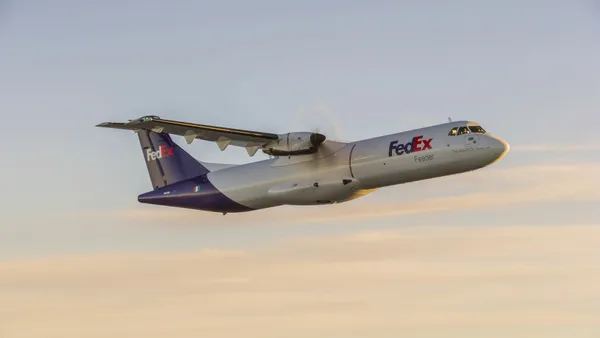Dive Brief:
- Air cargo demand continued its growth from pre-pandemic levels, with August volumes up 1% from 2019 levels, according to Clive Data Services. However, freighter suspensions in Shanghai added further pressure on already low air cargo capacity.
- Capacity has recovered from its pandemic lows, up 18% from August 2020. But it's still down 16% from August 2019, as international passenger airline activity hasn't yet returned to pre-pandemic levels, according to Clive.
- The late August closure of the Shanghai Pudong International Airport Cargo Terminal, known as PACTL, contributed to an 18% drop in westbound capacity from China, according to Clive. "As a result, spot rates increased by nearly 20% in the last week of August compared to the last week of July," it said in a news release.
Dive Insight:
Even as air cargo capacity recovers, the closure of PACTL shows how COVID-19-related disruptions can still spark noticeable swings in availability and spot rates.
"When something like this happens at what is the world's third largest cargo airport, it only reflects how fragile things are for global supply chains and the immediate impact on rates which were already high," said Clive Managing Director Niall van de Wouw in a statement.
The Shanghai Pudong airport's handling capabilities are improving and freighters are returning since PACTL shut down Aug. 20 due to reported COVID-19 cases among cargo workers, Flexport said in a Sept. 21 market update. But even excluding that airport, "the market is still very constrained," Flexport said.
Retailers have been competing for capacity ahead of the holiday season and have been diverting freight from ocean carriers amid continued congestion at ports and the need to restock. On Gap's Q2 earnings call, CFO Katrina O'Connell said the company has made "sizable investments in airfreight to partially mitigate longer lead times and shipping delays so that our inventories will be well-positioned to compete during back-to-school and holiday."
Air carriers aren't expecting capacity constraints to go away any time soon. FedEx Chief Marketing and Communications Officer Brie Carere said on the company's Q1 earnings call Tuesday that capacity is expected to be constrained through at least the first half of calendar year 2022, with a full recovery "not anticipated until 2024."
Improvements in business confidence among airlines have slowed recently due in part to the COVID-19 delta variant, according to the International Air Transport Association. The European Union recommended restrictions in August for U.S. travelers following an increase in COVID-19 cases, which could lead to demand — and then capacity — plummeting further.
"Shippers want to see more cargo capacity from the return on airline passenger operations, but some signals suggest this may get pushed back again on intercontinental routes following the recent EU recommendation to pause on all non-essential travel from the US to Europe," said van de Wouw.














